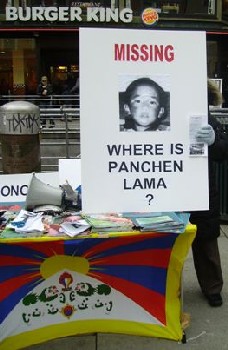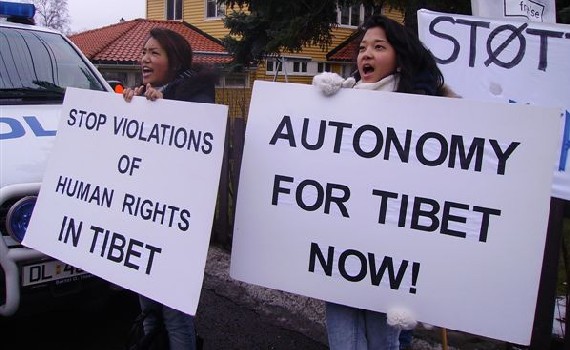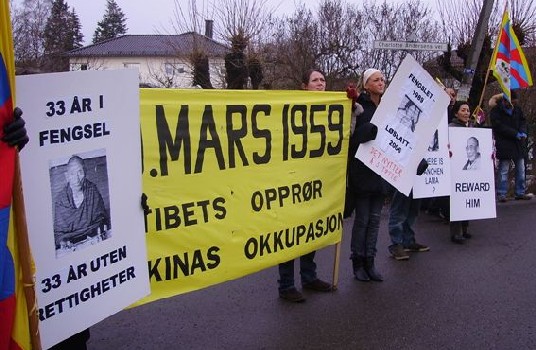Today, 10 March, marks the anniversary of the Tibetan uprising against the Chinese occupation of Tibet. 48 years ago to the day, Tibetans took to the streets of Lhasa, their capital, to protest the Chinese invasion and occupation. A week later, Dalai Lama, right, had to flee to India. In the months following his escape, thousands of Tibetans were killed by the Chinese Army. Right, demonstrators outside the Chinese Embassy demanding a free Tibet. (10-MAR-07)
Written by Chungdak Koren, Chairperson of the Norwegian Tibet Committee, this article has been translated, edited and prepared for publication by HRH F / Niels Jacob Harbitz. All photos from the Norwegian Tibet Committee´s demonstrations downtown Oslo and outside the Chinese Embassy of Norway today: The Norwegian Tibet Committee / Gudveig Molven.
 On 1 march 1959, while Dalai Lama was staying in the Johkang temple, he was visited by two young Chinese officers, who brought an invitation to a theatre performance to be held at the Chinese Army’s headquarters in Lhasa. Dalai Lama was put under pressure to accept, and responded by way of telling the officers that when the religious holiday he was observing at Johkang was over, he would come. They agreed to meet 10 March.
On 1 march 1959, while Dalai Lama was staying in the Johkang temple, he was visited by two young Chinese officers, who brought an invitation to a theatre performance to be held at the Chinese Army’s headquarters in Lhasa. Dalai Lama was put under pressure to accept, and responded by way of telling the officers that when the religious holiday he was observing at Johkang was over, he would come. They agreed to meet 10 March.
For several reasons, however, this was a strange invitation. First, it was not sent according to protocol via Kashag, the Tibetan government. Second, Dalai Lama was not invited to where theatre performances were normally held. Instead, he was invited to show up at the military headquarters. Third, he was asked to appear alone, without anyone accompanying him.
 For this particular occasion of Dalai Lama’s leaving of his residence Norbulingka to visit the Chinese Army headquarters three kilometers away, the message from the military leadership was that normal protocol should not be observed. He was not to be escorted by his own armed security guards, and Tibetan soldiers were not under any circumstance permitted to cross the Stone bridge, a landmark on the outskirts of the Chinese Army barracks. In addition, it was made clear from the Chinese that the Dalai Lama’s visit ought to take place in utmost secrecy.
For this particular occasion of Dalai Lama’s leaving of his residence Norbulingka to visit the Chinese Army headquarters three kilometers away, the message from the military leadership was that normal protocol should not be observed. He was not to be escorted by his own armed security guards, and Tibetan soldiers were not under any circumstance permitted to cross the Stone bridge, a landmark on the outskirts of the Chinese Army barracks. In addition, it was made clear from the Chinese that the Dalai Lama’s visit ought to take place in utmost secrecy.
When word of the Chinese invitation nevertheless got out, 30.000 Tibetans gathered, like a protective wall, around Norbulingka. Their fear was that the Dalai Lama would be kidnapped by the Chinese and forced to appear at the forthcoming congress of the Chinese National Assembly. Prevented from honouring the invitation by the sea of people surrounding Norbulingka, Dalai Lama had to give a late notice of decline. Two days later, on 12 March, 5.000 Tibetan women walked through the streets of Lhasa shouting, “From today, Tibet is independent”. Carrying big banners demanding “Tibet for Tibetans,” they appealed to the Indian Council General in Lhasa for help.
 While supporters of the public gathering barricaded themselves in the narrow passages of Lhasa, the Chinese Army established its sandbag machine gun strongholds on the city’s flat rooftops. 3.000 Tibetans in Lhasa volunteered to join the uprising. On 15 March, 3.000 among the Dalai Lama’s self-established security guards left Lhasa to position themselves along what could be his escape route, placing their best men in the most strategic points. To obfuscate what would be the most likely route, soldiers of the Tibetan Army blended with Lhasa civilians, hiding in the crowds. Considering the weakness of the Tibetan Army as compared to the Chinese, some 2 : 25 in sheer numbers of soldiers, such guerrilla tactics were the only option. Comparing military hardware further emphasises the dissimilarities. While the Chinese had all modern arms and support equipment, with 17 mobile cannon positions surrounding Lhasa, the Tibetans used mules to get their miniscule mortars in place.
While supporters of the public gathering barricaded themselves in the narrow passages of Lhasa, the Chinese Army established its sandbag machine gun strongholds on the city’s flat rooftops. 3.000 Tibetans in Lhasa volunteered to join the uprising. On 15 March, 3.000 among the Dalai Lama’s self-established security guards left Lhasa to position themselves along what could be his escape route, placing their best men in the most strategic points. To obfuscate what would be the most likely route, soldiers of the Tibetan Army blended with Lhasa civilians, hiding in the crowds. Considering the weakness of the Tibetan Army as compared to the Chinese, some 2 : 25 in sheer numbers of soldiers, such guerrilla tactics were the only option. Comparing military hardware further emphasises the dissimilarities. While the Chinese had all modern arms and support equipment, with 17 mobile cannon positions surrounding Lhasa, the Tibetans used mules to get their miniscule mortars in place.
 On 16 March, people observed that heavy Chinese artillery was being placed around Lhasa, and particularly around Norbulingka. Rumours circulated that more Chinese troops were on their way. Towards the end of the day, people were certain the Dalai Lama’s residence would be attacked. The following evening, they were proven right. The Chinese fired two grenades at Norbulingka, both landing in a marsh near the actual residence. The incidence made the Dalai Lama finally decide to leave his home country. In the evening of the 17 March, dressed in a military uniform and with a gun hanging over his shoulder, the Dalai Lama walked out of the gates of Norbulingka without anyone recognising him. Thus begun the dangerous journey to India, to freedom. His mother and elder sister had already left. Two weeks later, on 31 March, the Dalai Lama crossed the border to India at the Khenzimane pass.
On 16 March, people observed that heavy Chinese artillery was being placed around Lhasa, and particularly around Norbulingka. Rumours circulated that more Chinese troops were on their way. Towards the end of the day, people were certain the Dalai Lama’s residence would be attacked. The following evening, they were proven right. The Chinese fired two grenades at Norbulingka, both landing in a marsh near the actual residence. The incidence made the Dalai Lama finally decide to leave his home country. In the evening of the 17 March, dressed in a military uniform and with a gun hanging over his shoulder, the Dalai Lama walked out of the gates of Norbulingka without anyone recognising him. Thus begun the dangerous journey to India, to freedom. His mother and elder sister had already left. Two weeks later, on 31 March, the Dalai Lama crossed the border to India at the Khenzimane pass.
 In the evening of 19 March, an open battle begun in Lhasa. The shooting lasted for two days, with the Tibetan resistance at hopeless odds to keep its positions, let alone make any kind of headway. On 21 March, the Chinese bombarded Norbulingka with 800 granades. Thousands of men, women and children camping around the Dalai Lama’s residence in an attempt to continue the human shield that had initially served so well to protect their spiritual leader were killed. In addition, the homes of some 300 people working at Norbulingka were levelled to the ground by the bombing. After the Chinese had defeated the Tibetan uprising, 200 of Dalai Lama’s security guards were arrested and publicly executed. Lhasa’s hreat monasteries; Ganden, Sera and Drepung, were set under heavy artillery attacks, the latter left totally in ruins. Old monastery treasures and key Buddhist documents
In the evening of 19 March, an open battle begun in Lhasa. The shooting lasted for two days, with the Tibetan resistance at hopeless odds to keep its positions, let alone make any kind of headway. On 21 March, the Chinese bombarded Norbulingka with 800 granades. Thousands of men, women and children camping around the Dalai Lama’s residence in an attempt to continue the human shield that had initially served so well to protect their spiritual leader were killed. In addition, the homes of some 300 people working at Norbulingka were levelled to the ground by the bombing. After the Chinese had defeated the Tibetan uprising, 200 of Dalai Lama’s security guards were arrested and publicly executed. Lhasa’s hreat monasteries; Ganden, Sera and Drepung, were set under heavy artillery attacks, the latter left totally in ruins. Old monastery treasures and key Buddhist documents  were destroyed. Thousands of monks were either killed on the spot, deported or taken to town as slaves. The Chinese went from house to house searching for weapons. If any were found, the supposed owners were dragged on to the streets and shot. Only in Central Tibet, more than 86.000 Tibetans were killed by the Chinese during this short period in 1959. Ever since, the Chinese has continued to discriminate, suppress, torture and kill Tibetans. With the world’s attention turning to the People´s Republic of China and the 2008 Beijing Summer Olympics looming only about a year and a half away, the occupation continues, with no change, neither in attitude nor in action, in sight from the Chinese. Hence, the global protests also continue, with unflinching passion, power and hope of ultimate progress.
were destroyed. Thousands of monks were either killed on the spot, deported or taken to town as slaves. The Chinese went from house to house searching for weapons. If any were found, the supposed owners were dragged on to the streets and shot. Only in Central Tibet, more than 86.000 Tibetans were killed by the Chinese during this short period in 1959. Ever since, the Chinese has continued to discriminate, suppress, torture and kill Tibetans. With the world’s attention turning to the People´s Republic of China and the 2008 Beijing Summer Olympics looming only about a year and a half away, the occupation continues, with no change, neither in attitude nor in action, in sight from the Chinese. Hence, the global protests also continue, with unflinching passion, power and hope of ultimate progress.





